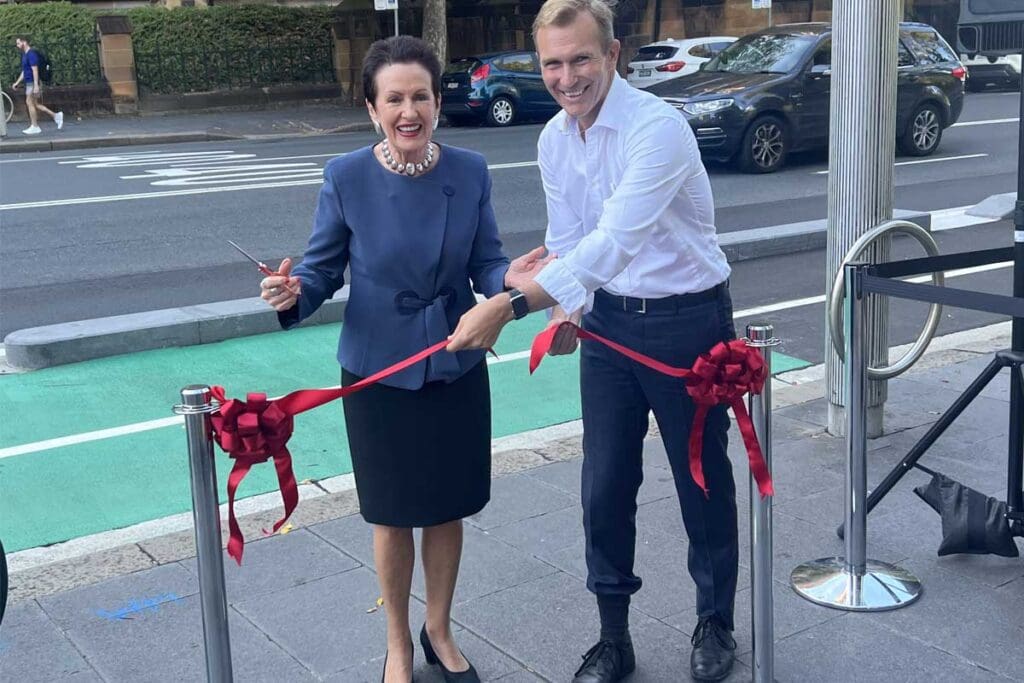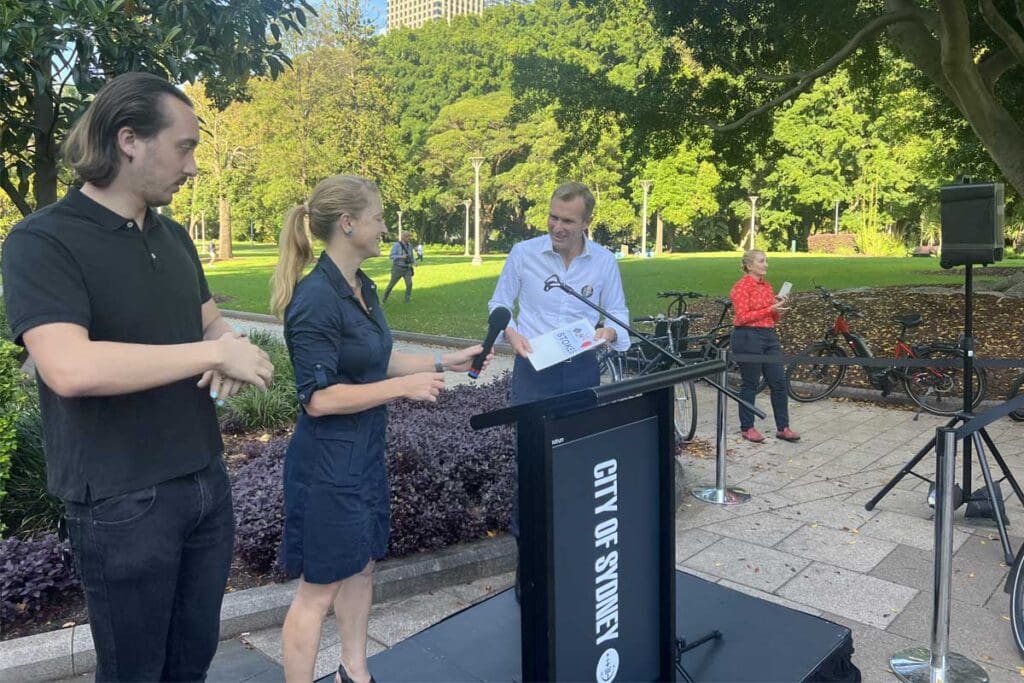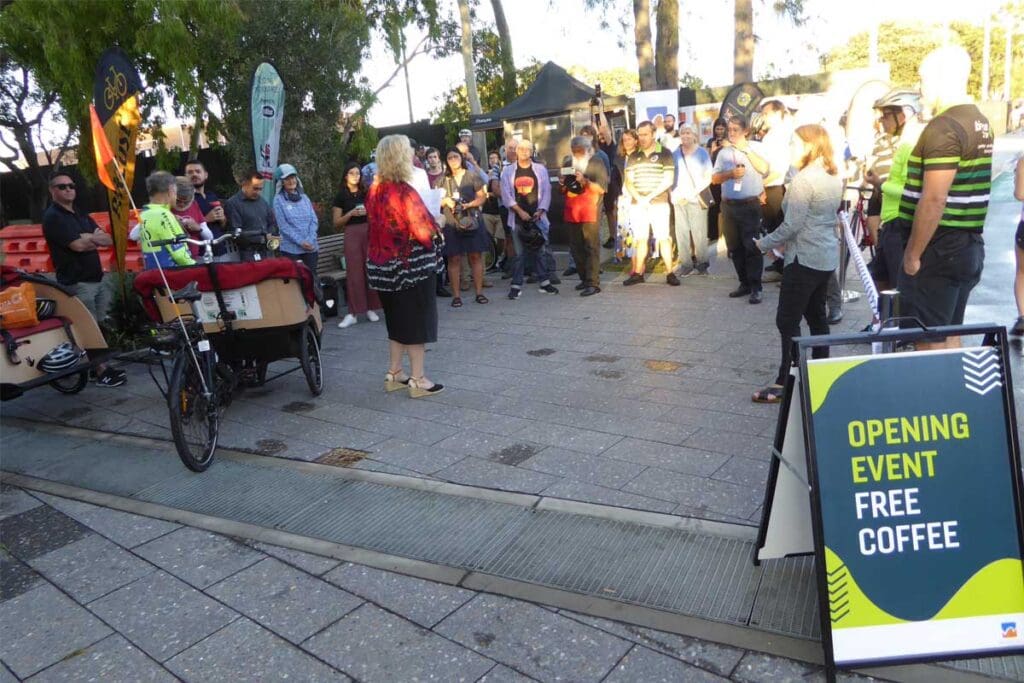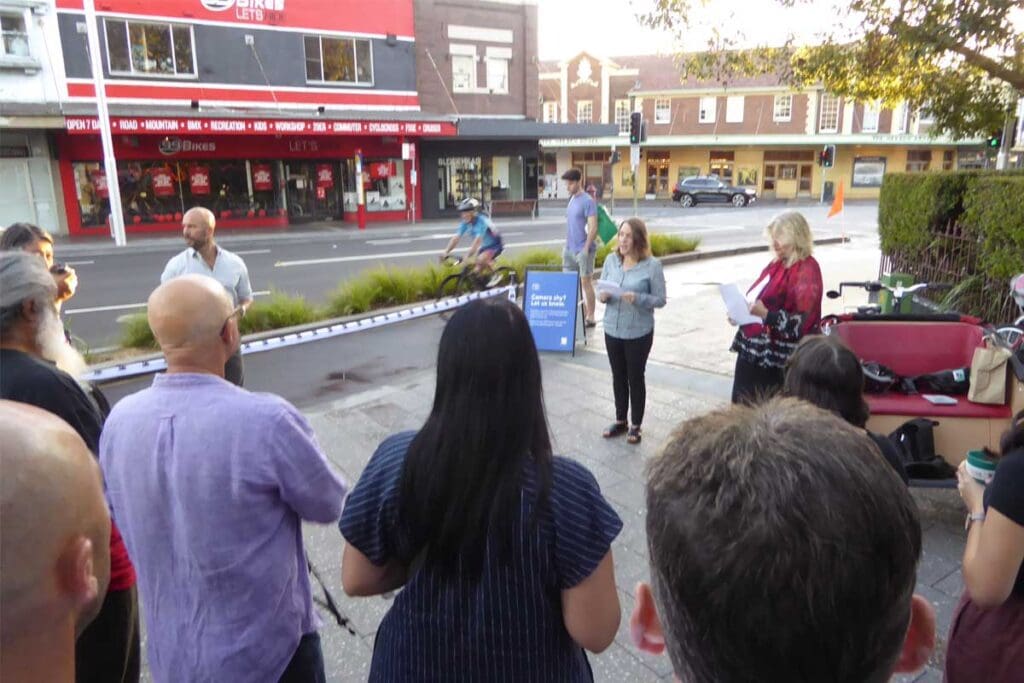Smiles and Celebrations as Two Hard-Won Projects Open

Sydney, NSW
Two significant protected bike lane projects had their official opening ceremonies just one week apart in Sydney during March 2023.
In both cases, it took more than a decade of struggle from cycling advocates to ensure these short but heavily used and strategically placed pieces of infrastructure were built.
College Street Cycleway
As we have previously reported here, the College Street Cycleway has already had a long and storied history.
College Street is one of the widest north/south main roads in Sydney’s CBD. It runs along the eastern boundary of Hyde Park, past landmarks including St Mary’s Cathedral and the National Museum.
Despite having more than 2,000 cyclists per day using the path, it was ripped out in 2015 by the anti-cycling NSW Roads Minister of that time. This event made world news among cycling and active transport media at the time because it was against the flow of what was an accelerating trend towards new infrastructure.
Fortunately, the cycleway has been rebuilt. It already has new links to the north and soon the Oxford Street / King Street cycleways will be constructed and link to its southern end. Ultimately, the Oxford Street cycleway will link to the Bondi Junction cycleway that opened a week earlier and that we write about at the end of this article.
There was a celebratory atmosphere at the official opening ceremony for the College Street Cycleway, which was hosted by the City of Sydney and held at 8.30am on Thursday 16th March, at the northern start of the cycleway, which is directly opposite the cathedral.
“We’ve had a long history here as many of you know,” City of Sydney Lord Mayor Clover Moore told the assembled crowd of up to 100 cycling advocates, who were very vocal with their cheers and applause at several points during the formalities.
“Today is a very happy occasion because we are at last officially celebrating the reopening of the College Street cycleway, which is an important link in the city’s bicycle network.
“It means that bike riders will again have a safe, separated cycleway linking them to the north, south, east and west of Sydney. It is a really important connection.

“The city of Sydney spent $4 million building this important link in 2010. It was summarily removed, at night I’ve got to say, under the direction of the former Minister for Roads, Duncan Gay, and I understand that when people cycled by his place this morning they gave him a special ring on their bells.
“That’s why it’s so nice to have Minister Rob Stokes here this morning. We’ve come full circle.
“Even though it was pulled out, this has still been one of most heavily used cycle routes in Sydney, with more than 2,000 cyclists using it each day, but the problem was it was very unsafe,” she said, referring to the busy six lane road with no protection after the protected lane was removed.
“When we first started this work back in 2008, as many of you will remember, our bike lanes were met by furious opposition. The removal of the College Street Cycleway came despite some of the largest cycling protests ever seen in the city.
“The good news now is that the (NSW) government has spent $5 million replacing this link.
“This financial year alone the City of Sydney has opened 2.6 kilometres of new cycleways. Since 2007, we’ve delivered 25 kilometres of safe, separated cycleways.
“Seventy-two percent of Sydneysiders support separated cycleways and most want Sydney’s bike network to be built faster. Businesses have been very strong supporters. They’ve invested $57 million in bike parking and shower facilities, encouraging their employees to cycling.
“We have a very new public end-of-trip facility at 180 George Street, near Circular Quay. This will have 200 bike parks, showers and lockers.”
We have previously written about that brand new facility here.
Cr Moore continued: “Not everyone can ride – separated cycleways ease traffic congestion for those who need to drive. More bikes means fewer cars on the road. For every dollar spent on cycleways at least $2.68 of benefits return – much more than motorways.

“In reopening this cycleway I’m reminded of the quote attributed to John Lennon, ‘Everything will be ok in the end. If it’s not ok, it’s not the end.’ I think we’ve reached the end here with the College St Cycleway.”
The mayor then introduced the Minister for Active Transport, Rob Stokes, who was looking particularly relaxed for a politician just nine days prior to an election. That would no doubt in part be because Minister Stokes had already announced prior to the election campaign that he would be retiring from politics and not seeking re-election.
“What an extraordinary occasion,” he began. “It is a great honour to follow Clover Moore, Lord Mayor of Sydney, speaking to you at this celebration this morning.
“Cycling is actually deeply democratic. It’s about being able to use public spaces to get around as people want to. And to get around in a way that is efficient, that is healthy, that is good for our bodies, minds, spirits, is great for the environment, our wallets. Basically, on any indices of efficiency, cycling is good for our society.
“It’s with some degree of sheepishness that I speak to you today because of course I’m mindful of the fact that, well, it was my government that ripped up this cycleway in the first place, but it’s nice to be able to put it back. It’s important to be able to learn from our mistakes and that’s what we’ve done.
“Clover quite appropriately quoted John Lennon. I, as a conservative politician, should quote Winston Churchill … ‘This is not the end. This is not even the beginning of the end. This is merely the end of the beginning.’
“There’s a lot more work to be done. While the City of Sydney has led, in partnership with the (NSW) government, there’s plenty of other councils that need to follow the City of Sydney’s lead. That’s what we all need to do now, in all of our various communities, to go and advocate for better cycling infrastructure.
“I know there continues to be antipathy towards cycling and cyclists. That is completely irrational. To shopkeepers, we need to explain that people who are walking or cycling are far more likely to stop in their shops than people who are motoring past.”
He concluded: “I could speak for hours on this. But this is a campaign that’s worth participating in. It’s deeply democratic. It’s all about freedom and it’s just a wonderful privilege to be in conjunction with the City of Sydney. It just shows what a group of people working together can achieve.”
Exclusive: Five Questions for the Lord Mayor of Sydney
After the College Street Cycleway reopening formalities were complete, we had the opportunity for a brief one-on-one interview with the Lord Mayor of Sydney, Clover Moore, who has been continuously an elected official across many roles in both State and local governments since 20th September 1980.
Clover Moore has been the Lord Mayor of Sydney for almost 19 years and has won five consecutive elections, always by substantial majorities, making her one of Australia’s most successful politicians.
She was also a state politician for 24 years until the government of the day enacted what the media quickly dubbed the first ‘Get Clover’ law, which prevented dual membership of the State Government and a local council. She chose to keep her role as Mayor and leave state politics.
In the second ‘Get Clover’ law, the State Government changed the voting system solely for the City of Sydney, but none of the other councils throughout NSW. The ‘City of Sydney Amendment (Elections) Bill’ became law in September 2014. It replaced one optional vote per business with two compulsory votes, while the private residents still only had one vote per person. This seemingly undemocratic law was enacted by the same conservative Liberal government under premier Mike Baird that ripped out the College Street Cycleway. The logic behind this law was that, unlike local residents, businesses from the ‘big end of town’ in Sydney’s CBD would not like Clover Moore’s cycling and more general environmental advocacy and would vote her out. But at the subsequent council election, she was not only returned, but her independent team of councillors grew from five to six of the 10 seats.
As we have previously written about here, this pattern is consistent not only throughout Australia but around the world. Mayors who advocate for more environmentally friendly policies, including bike lanes, are not only re-elected, but often with increased majorities, despite the invariably hostile campaigns against them by certain sections of the media.
If you would like some more background on Cr Moore’s epic almost half-century of community activity, then this link is a good place to start.
Micromobility Report How does it feel to be reopening this bike lane after it was previously demolished?
Clover Moore It’s really good! It’s a real celebration. It was such a destructive, ugly thing, to rip out our bike lane that we’d spent $4 million on and was a very important connection. It was just heartbreaking back in 2015.
MR Who paid for the reconstruction?
CM The (NSW) government. Which is why I was really pleased to have Minister Stokes here. As they should. They wasted $4 million in removing it.
MR How does the current level of opposition to new bike lane projects from some media and some members of the public, compare to back in 2010 when you were working on the Bourke Street protected bike lane? (This was a landmark project that attracted fierce opposition from the tabloid media in particular.)
CM Well, there’s great acceptance by the community and by government, except when you go to put it in. Woollahra Council is dealing with it at a meeting on Monday night. Oxford Street is a very important connector and there’s a section that goes through their area. On the City (of Sydney) side of Oxford St, not on the Woollahra side (Oxford Street forms small segment of the Woollahra Council boundary). So it’s going to have minimal impact in Woollahra. But there was some opposition from some of those councillors to the cycleway as there has been over the past decade.
It’s just an ongoing battle. It’s just this thing of, ‘I love separated bike lanes but not in my street, not in my neighbourhood’.
We forge ahead anyway and the majority support it.
MR What other active transport and cycling improvements do you hope to see open during your remaining time as Lord Mayor?
CM Well, we’re just continually building our separated network. Then once we have finished our work, we want it to connect up to all the surrounding neighbourhoods. We’d like to see a metropolitan-wide network. But those councils around us need to get support from federal and State governments to do it. That’s the vision.
MR You’ve been mayor longer than any other mayor in the history of Sydney since 1842. How much of a factor do you think your pro-cycling policies and your broader environmental policies have been in your electoral success?
CM I think in the City of Sydney, the majority of people are intelligent, thinking people and they support the work that we do. That is considered by others to be quite radical and it’s not really what other cities around the world do. But we’re creating a city for people, a city where people want to live, work, move around safely. We’re creating a beautiful city – a lot of tree planting, a lot of public art.
Bring all those things together and I think people will support it.
Bondi Junction Cycleway Opens After a Decade of Campaigning
Bondi Junction is a very busy and densely-packed business and shopping precinct located about six kilometres south-east of Sydney’s CBD. It’s also an upmarket residential area, where the median house price is $2.5 million and median unit price is $1.4 million.

Bondi Junction is part of the Waverley Council area, which has a timid track record when it comes to pushing ahead with cycling infrastructure. It commissioned the design of the Bondi Junction Cycleway in 2014 and endorsed the design in December 2017. It was not until $6 million in NSW government funding was released in the 2019-2020 financial year that the project was likely to proceed and it’s taken another three years until construction is now complete.

This significant occasion was celebrated with an official opening ceremony, pictured here, which was held on Thursday 9th March 2023. In addition to Waverley Council Mayor Paula Masselos, those in attendance included Waverley Councillors Dominic Wy Kanak and Ludovico Fabiano, Bicycle NSW CEO Peter McLean and BIKEast President Mark Worthington.

According to a Waverley Council report, they’re already measuring 7,500 cyclists per week using the new cycleway. This number should increase significantly when the new Oxford Street Cycleway is constructed and links the Bondi Junction Cycleway to a network that can take riders all the way into the CBD and beyond on protected paths.
